- Home
- Anne O'Brien
The King’s Concubine: A Novel of Alice Perrers
The King’s Concubine: A Novel of Alice Perrers Read online
PRAISE FOR THE NOVELS OF ANNE O’BRIEN
The King’s Concubine
“The King’s Concubine is a delicious and satisfying Cinderella story, following the rise of Alice Perrers from powerless naivety to the pinnacle of the realm as the mistress of Edward III. Anne O’Brien brings Alice’s story to life with vivid details and glorious writing that will please any fan of historical fiction.”
—Gillian Bagwell, author of The September Queen
Queen Defiant
“Queen Defiant lives up to its title as Anne O’Brien, with sensual lyricism, gifts readers with the lesser-known story of Eleanor of Aquitaine before Henry Plantagenet swept her away to immortality. Married to the monk-king of France, Louis II, Eleanor fights Louis, the Church, and the French nobility to go on crusade to Jerusalem, where she finds unexpected sexual fulfillment before a much younger Henry pursues and wins her to an even greater love. We are more familiar with her tumultuous story as England’s great queen, but O’Brien brings us the equally fascinating tale of Eleanor’s little-known earlier years, the years that gave her an enduring defiance and strength that she would need for the rest of her life.”
—Jeane Westin, author of His Last Letter and The Virgin’s Daughters
“Passionate and romantic…Queen Defiant is another fascinating look at the early life of Eleanor of Aquitaine. O’Brien’s Eleanor is a fine tribute to the woman that she was historically: complex, ambitious, intelligent, and alluring. Eleanor of Aquitaine would be proud.”
—Examiner.com (Pittsburgh)
“Eleanor is the picture of defiance, and her bold, fiery voice is the strongest asset of this successful historical.”
—Publishers Weekly
“The reader is taken on a roller-coaster ride through Eleanor’s emotions and her story, and you just cannot help but fall in love with this passionate heroine.…O’Brien brings Eleanor, Louis, Henry, Aquitaine, and Paris to life with her writing, and it is a gripping story [that] the reader will find hard to put down.…This is a wonderful romp through Eleanor’s life.”
—The Anne Boleyn Files
“Anne O’Brien provides a fresh perspective [on Eleanor’s life]…engaging.”
—Genre Go Round Reviews
The Virgin Widow
“Packed with royal intrigue and stunning reversals of fortune, The Virgin Widow is a thrilling romance drawn from history, beautifully told. Anne O’Brien’s spirited and courageous heroine, Lady Anne Neville, a traitor’s daughter and future Queen of England, vividly narrates her incredible journey through treachery and heartbreak into the arms of the man she loves—the last Plantagenet King of England, Richard III.”
—Sandra Worth, award-winning author of Pale Rose of England
“O’Brien pulls us by our heartstrings through the power struggles between the House of York and Lancaster, telling the story through the seemingly hopeless love of Anne Neville for the man who would become Richard III…a little-known story that you will never forget.”
—Jeane Westin
“The Virgin Widow is a novel so engrossing that I couldn’t put it down. Anne Neville comes to full and glorious life on these pages—a courageous woman of her own time, timeless in her appeal to readers.”
—Kate Emerson, author of Secrets of the Tudor Court: At the King’s Pleasure
“Anne O’Brien’s The Virgin Widow takes the reader on a compelling journey through medieval history and the heart of Anne Neville, a pawn and power in Plantagenet England. The vibrant characters, especially the narrator heroine, leap off the page. O’Brien weaves love, lust, tragedy, and triumph into a rich historical tapestry to treasure.”
—Karen Harper, national bestselling author of Mistress Shakespeare and The Irish Princess
“The Virgin Widow is the finest portrayal of Anne Neville in historical fiction. It gives a flattering portrayal of Anne, a historically accurate view of this tumultuous time in England, and great romance and drama. O’Brien’s first venture into novels on historical figures gets two thumbs up.”
—Examiner.com (Pittsburgh), included in the Best Ten Historical Novels of 2010
“O’Brien has excellent control over the historical material and a rich sense of characterization, making for a fascinating and surprisingly female-focused look at one of the most turbulent periods of English history.”
—Publishers Weekly
“A strong tale filled with intrigue, a deep understanding of historical events, and a far more sympathetic portrait of Richard III than Shakespeare’s that will fascinate readers.”
—Romantic Times
“If you need a good book for holiday reading or for relaxing with in the garden on a sunny day, you just cannot go wrong with this one. All of the right ingredients: romance, intrigue, betrayal, glamour, history, murder…brilliant!”
—The Anne Boleyn Files
“With this winning novel, Anne O’Brien has joined the exclusive club of excellent historical novelists.”
—Sunday Express (UK)
Other Novels by Anne O’Brien
Queen Defiant
The Virgin Widow
THE KING’S
CONCUBINE
A NOVEL OF ALICE PERRERS
Anne O’Brien
NEW AMERICAN LIBRARY
NEW AMERICAN LIBRARY
Published by New American Library, a division of
Penguin Group (USA) Inc., 375 Hudson Street,
New York, New York 10014, USA
Penguin Group (Canada), 90 Eglinton Avenue East, Suite 700, Toronto,
Ontario M4P 2Y3, Canada (a division of Pearson Penguin Canada Inc.)
Penguin Books Ltd., 80 Strand, London WC2R 0RL, England
Penguin Ireland, 25 St. Stephen’s Green, Dublin 2,
Ireland (a division of Penguin Books Ltd.)
Penguin Group (Australia), 250 Camberwell Road, Camberwell, Victoria 3124,
Australia (a division of Pearson Australia Group Pty. Ltd.)
Penguin Books India Pvt. Ltd., 11 Community Center, Panchsheel Park,
New Delhi - 110 017, India
Penguin Group (NZ), 67 Apollo Drive, Rosedale, Auckland 0632,
New Zealand (a division of Pearson New Zealand Ltd.)
Penguin Books (South Africa) (Pty.) Ltd., 24 Sturdee Avenue,
Rosebank, Johannesburg 2196, South Africa
Penguin Books Ltd., Registered Offices:
80 Strand, London WC2R 0RL, England
First published by New American Library,
a division of Penguin Group (USA) Inc.
First American Printing, June 2012
10 9 8 7 6 5 4 3 2 1
Copyright © Anne O’Brien, 2012
Readers Guide copyright © Penguin Group (USA) Inc., 2012
All rights reserved. No part of this book may be reproduced, scanned, or distributed in any printed or electronic form without permission. Please do not participate in or encourage piracy of copyrighted materials in violation of the author’s rights. Purchase only authorized editions.
REGISTERED TRADEMARK—MARCA REGISTRADA
Library of Congress Cataloging-in-Publication Data:
O’Brien, Anne, 1949–
The king’s concubine: a novel of Alice Perrers/Anne O’Brien.
p. cm
ISBN: 978-1-101-58667-9
1. Perrers, Alice, ca. 1348–1400—Fiction. 2. Ladies-in-waiting—Great Britain—Fiction. 3. Edward III, King of England, 1312–1377—Fiction. 4. Great Britain—Kings and rulers—Paramours—Fiction. 5. Mistresses—Great Britain—Fiction. I. Title.
PR6115.B7355K56 2012
823’.92—dc23 2011048198
Set in Simoncini Garamond
Designed by Alissa Amell
Printed in the United States of America
Without limiting the rights under copyright reserved above, no part of this publication may be reproduced, stored in or introduced into a retrieval system, or transmitted, in any form, or by any means (electronic, mechanical, photocopying, recording, or otherwise), without the prior written permission of both the copyright owner and the above publisher of this book.
PUBLISHER’S NOTE
This is a work of fiction. Names, characters, places, and incidents either are the product of the author’s imagination or are used fictitiously, and any resemblance to actual persons, living or dead, business establishments, events, or locales is entirely coincidental.
The publisher does not have any control over and does not assume any responsibility for author or third-party Web sites or their content.
ALWAYS LEARNING
PEARSON
For George,
who managed to live comfortably for a year with both me and Alice Perrers. As ever, with love and thanks.
Acknowledgments
All my thanks:
To my agent Jane Judd, who appreciated the possibility of Alice Perrers as an unconventional heroine. Her advice and support, as always, are beyond price.
To Jennifer Unter, my “agent over the pond,” who continues to support me and my historical heroines.
To Ellen Edwards and her exceptional team at NAL. Their guidance and commitment were invaluable in enabling the real Alice Perrers to emerge from infamy.
To Helen Bowden and all at Orphans Press who come to my rescue and continue to create masterpieces out of my genealogy and maps.
To Phia McBarnet, who patiently introduced me to the benefits of social media and set my foot on the steep learning curve.
“There was…in England a shameless woman and wanton harlot called Ales Peres, of base kindred…being neither beautiful or fair, she knew how to cover these defects with her flattering tongue.…”
—A historical relation of certain passages about the end of King Edward III and of his death
“It is not fitting that all the keys should hang from the belt of one woman.”
—Thomas Brinton, Bishop of Rochester
“…no one dared to go against her…”
—Thomas Walsingham, a monk of St. Albans
Table of Contents
Prologue
Chapter One
Chapter Two
Chapter Three
Chapter Four
Chapter Five
Chapter Six
Chapter Seven
Chapter Eight
Chapter Nine
Chapter Ten
Chapter Eleven
Chapter Twelve
Chapter Thirteen
Chapter Fourteen
Chapter Fifteen
Chapter Sixteen
Chapter Seventeen
Epilogue
About the Author
The King’s Concubine
Prologue
“Today you will be my Lady of the Sun,” King Edward says as he approaches to settle me into my chariot. “My Queen of Ceremonies.”
And not before time!
I don’t say the words, of course—I am, after all, a woman of perception—but I think them. I have waited too many years for this acclaim. Twelve years as Edward’s whore.
“Thank you, my lord,” I murmur, curtsying deeply, my smile as sweet as honey.
I sit, a cloak of shimmering gold tissue spread around me to show a lining of scarlet taffeta. My gown is red, lined with white silk and edged in ermine: Edward’s colors, royal fur fit for a queen. Over all glitters a myriad of precious stones refracting the light: rubies as red as blood, sapphires dark and mysterious, strange beryls capable of destroying the power of poison. Everyone knows that I wear Queen Philippa’s jewels.
I sit at my ease, alone in my preeminence, my hands loose in my bejeweled lap. This is my right!
I look around to see if I might catch sight of the black scowl of the Princess Joan. No sign of her, my sworn enemy. She’ll be tucked away in her chamber at Kennington, ill-wishing me. Joan the Fair. Joan the Fat! An adversary to be wary of, with the sensitivity and morals of a feral cat in heat.
My gaze slides to Edward as he mounts his stallion, and my smile softens. He is tall and strong and good to look on. What a pair we make, he and I. The years have not yet pressed too heavily on him, while I am in my prime. An ugly woman, by all accounts, but not without talent.
I am Alice. Royal Concubine. Edward’s beloved Lady of the Sun…
Ah…! I blink as a swooping pigeon smashes the scene in my mind, flinging reality back at me with cruel exactitude. Sitting in my orchard, far from Court and my King, I am forced to accept the truth. How low have I fallen. I am caged in impotent loneliness, like Edward’s long-dead lion, powerless, isolated, stripped of everything I had made for myself.
I am nothing. Alice Perrers is no more.
Chapter One
Where do I start? It’s difficult to know. My beginnings as I recall them were not moments marked by joy or happiness. So I will start with what I do recall. My very first memory.
I was a child, still far too young to have much understanding of who or what I was, kneeling with the sisters in the great Abbey church of St. Mary’s. It was the eighth day of December and the air so cold it hurt my lungs as I breathed it in. The stone paving was rough beneath my knees, but even then I knew better than to shuffle. The statue on its plinth in the Lady Chapel was clothed in a new blue gown, her veil and wimple made from costly silk, startlingly white in the dark shadows. The nuns sang the office of Compline, and ’round the feet of the statue a pool of candles had been lit. The light flickered over the deep blue folds so that the figure appeared to move, to breathe.
“Who is she?” I asked, voice too loud. I was still very ignorant.
Sister Goda, novice mistress when there were novices to teach, hushed me. “The Blessed Virgin.”
“What is she called?”
“She is the Blessed Virgin Mary.”
“Is this a special day?”
“It is the feast of the Immaculate Conception. Now, hush!”
It meant nothing to me then, but I fell in love with her. The Blessed Mary’s face was fair, her eyes downcast; there was a little smile on her painted lips, and her hands were raised as if to beckon me forward. But what took my eye was the crown of stars that had been placed for the occasion on her brow. The gold gleamed in the candlelight; the jewels reflected the flames in their depths. And I was dazzled. After the service, when the nuns had filed out, I stood before her, my feet small in the shimmer of candles.
“Come away, Alice.” Sister Goda took my arm, not gently.
I was stubborn and planted my feet.
“Come on!”
“Why does she wear a crown of stars?” I asked.
“Because she is the Queen of Heaven. Now will you…”
The sharp slap on my arm made me obey; yet still I reached up, although I was too small to touch it, and smiled.
“I would like a crown like that.”
My second memory followed fast on my first. Despite the late hour, Sister Goda, small and frail but with a strong right arm, struck my hand with a leather strap until my skin was red and blistered. Punishment for the sin of vanity and covetousness, she hissed. Who was I to look at a crown and desire it for myself? Who was I to approach the Blessed Virgin, the Queen of Heaven? I was of less importance than the pigeons that found their way into the high reaches of the chancel. I would not eat for the whole of the next day. I would rise and go to bed with an empty belly. I would learn humility. And as my belly growled and my hand hurt, I learned, and not for the last time, that it was not in the nature of women to get what they desired.
“You are a bad child!” Sister Goda stated unequivocally.
I lay awake until the Abbey bell summoned us at two of the clock
for Matins. I did not weep. I think I must have accepted her judgment on me. Or I was too young to understand its implications.
And my third memory?
Ah! Vanity! Sister Goda failed to beat it out of me. She eyed me dispassionately over some misdemeanor that I cannot now recall.
“What a trial you are to me, girl! And most probably a bastard, born out of holy wedlock. An ugly one at that. I see no redeeming features in you, even though you are undoubtedly a creature of God’s creation.”
So I was ugly and a bastard. At twelve years old, I wasn’t sure which was the worse of the two. Was I ugly? Forbidden as we were the ownership of a looking glass in the Abbey—such an item was far too venal and precious to be owned by a nun—which of the sisters had never peered into a bowl of still water to catch an image? Or sought a distorted reflection in one of the polished silver ewers used in the Abbey church? I did the same and saw what Sister Goda saw.
That night I looked into my basin of icy water before my candle was doused. The reflection shimmered, but it was enough. My hair, close-cut against my skull, to deter lice as much as vanity, was dark and coarse and straight. My eyes were as dark as sloes, like empty holes eaten in cloth by the moth. As for the rest: My cheeks were hollow, my nose prominent, my mouth large. Even accepting the rippling flaws in the reflection, I was no beauty. I was old enough and female enough to understand, and be hurt by the knowledge. Horrified by my heavy brows, black as smudges of charcoal, I dropped my candle in the water, obliterating the image.
Lonely in the dark of my cold, narrow cell, the walls pressing in on me in my solitary existence, I wept. The dark, and being alone, frightened me.
As for the rest of my young days, all merged into a gray lumpen pottage of misery and resentment, stirred and salted by Sister Goda’s admonitions.
“You were late again for Matins, Alice. Don’t think I didn’t see you slinking into the church like the sly child you are!” Yes, I was late.
“Alice, your veil is a disgrace in the sight of God. Have you dragged it across the floor?” No, I had not, but against every good intention my veil collected burrs and fingerprints and ash from the hearth.

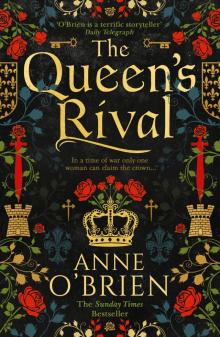 The Queen's Rival
The Queen's Rival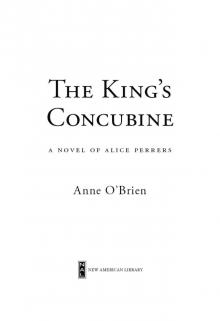 The King’s Concubine: A Novel of Alice Perrers
The King’s Concubine: A Novel of Alice Perrers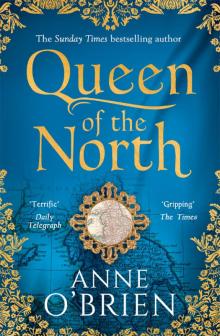 Queen of the North
Queen of the North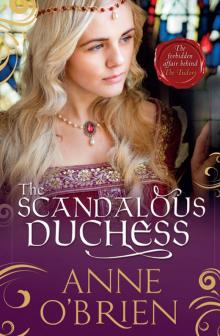 The Scandalous Duchess
The Scandalous Duchess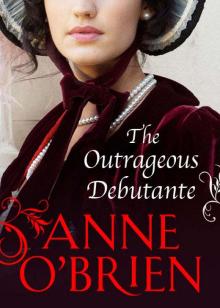 The Outrageous Debutante
The Outrageous Debutante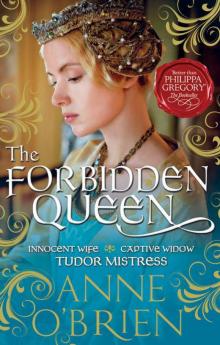 The Forbidden Queen
The Forbidden Queen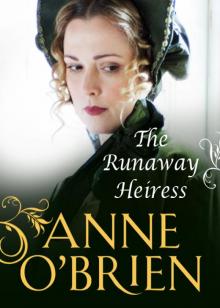 The Runaway Heiress
The Runaway Heiress Devil's Consort
Devil's Consort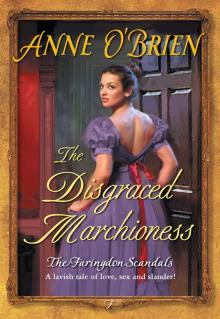 The Disgraced Marchioness
The Disgraced Marchioness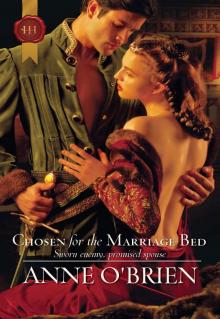 Chosen for the Marriage Bed
Chosen for the Marriage Bed Puritan Bride
Puritan Bride Battle-Torn Bride
Battle-Torn Bride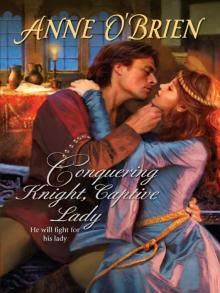 Conquering Knight,Captive Lady
Conquering Knight,Captive Lady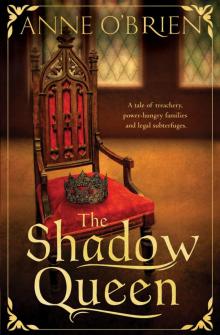 The Shadow Queen
The Shadow Queen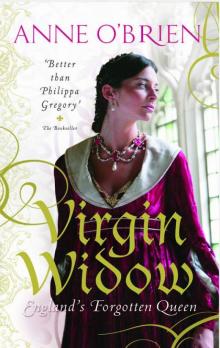 Virgin Widow
Virgin Widow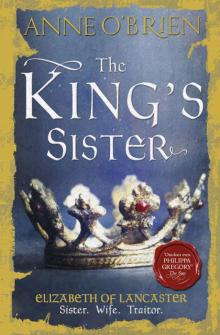 The King’s Sister
The King’s Sister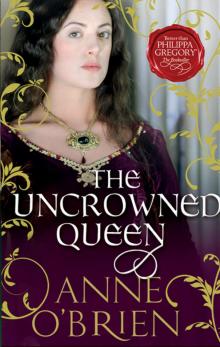 The Uncrowned Queen
The Uncrowned Queen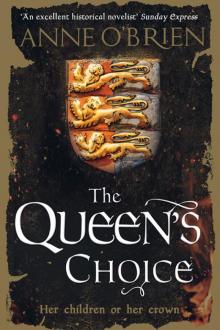 The Queen's Choice
The Queen's Choice